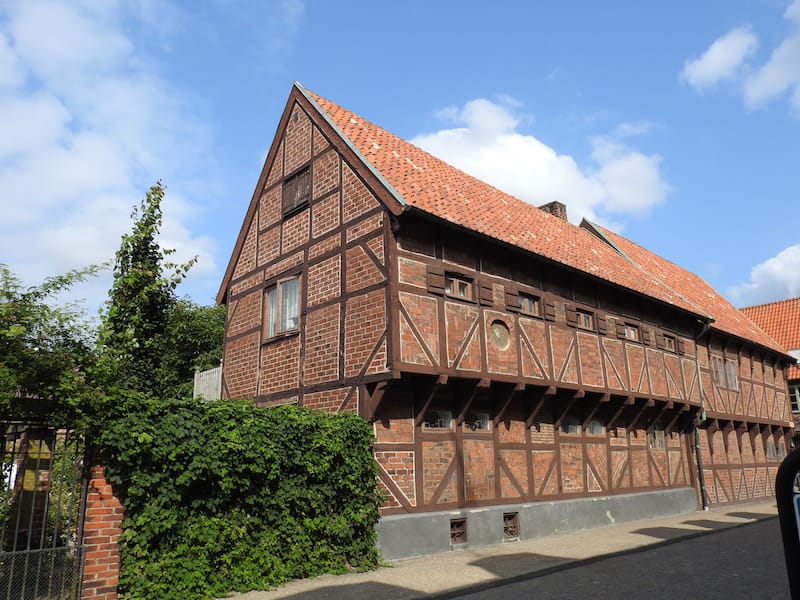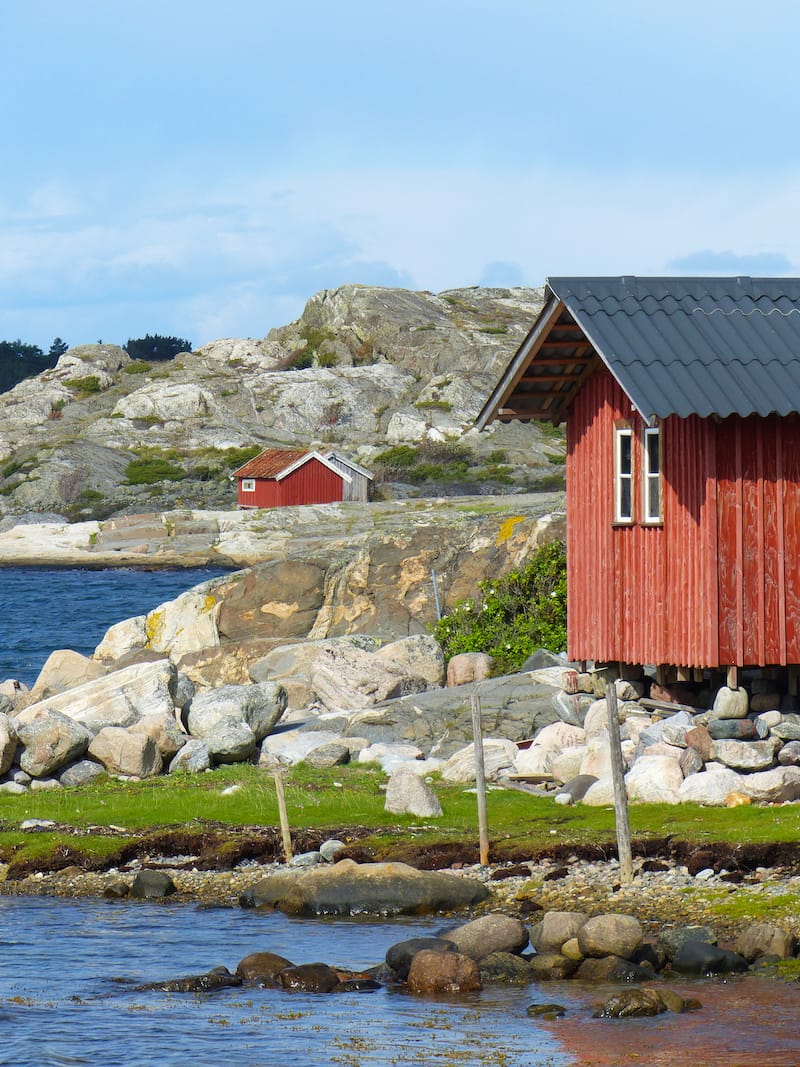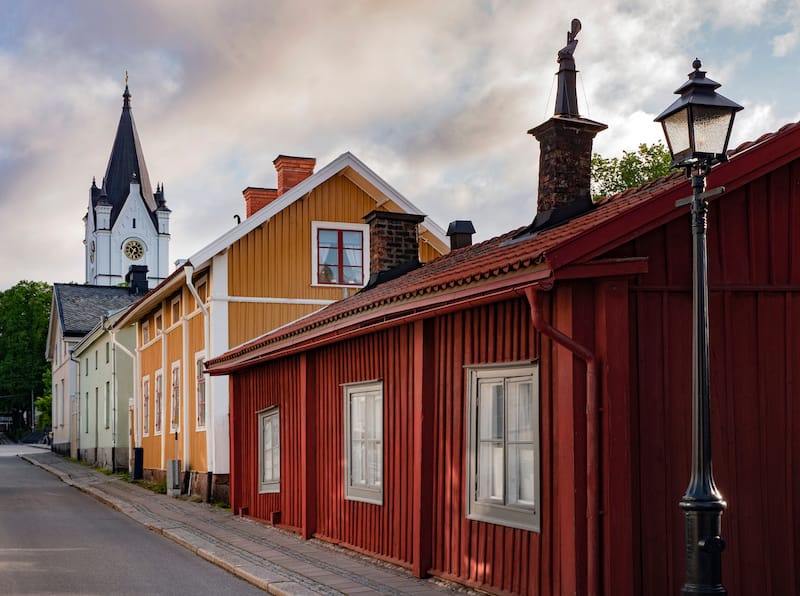Are you looking to visit some of the best small towns in Sweden (or smaller cities)? This guide has you covered!
In this guide, we discuss some of the most charming Swedish small towns, including some small cities (or lesser-known ones).

Did we miss any of your favorite small cities or towns in Sweden? Let us know in the comments!
Best Small Towns in Sweden
1. Sigtuna
To the north of Stockholm is a popular town known for its medieval churches and stone ruins – Sigtuna.
Walk on the oldest main street of Sweden, dating back to the time of King Erik the Victorious from the 10th century, called Stora Gatan. On that street, you’ll find shops, cafes, and restaurants lined throughout in traditional Swedish wooden houses.
Sigtuna was founded as the first Christian town in Sweden, and at its peak, there were seven large churches throughout the town.

Today, only the ruins of the medieval churches of Saint Lawrence, Saint Olaf, and Saint Peter remain.
Otherwise, the Saint Mary Church standing in the city center built by Dominican friars is a glimpse into the Christian past. The area is also famous for pre-Christian runestones!
2. Kalmar
To Sweden’s southeast on the Baltic Sea is Kalmar, a popular town renowned for its historic architecture and charming seaside.
Its main attraction is the emblematic Renaissance-style Kalmar Castle with its iconic ornate turrets and drawbridge overlooking the sea and the old town.
The cobbled streets of the old town lead you through alleys of 17th- and 18th-century buildings and homes, well-preserved and celebrated to this day.

The Kalmar Cathedral is another significant architectural gem of the city, featuring a 17th-century pulpit and a baroque altar.
Along the Baltic Sea from Kalmar is the Öland Bridge, which grants direct access to the island of Öland.
The Kalmar City Park has polished gardens and the Kalmar County Museum can provide more insight on the significance of the city.
3. Jokkmokk
In Sweden’s Lapland is Jokkmokk, a town particularly known for its Sami community and local engagement.
Every winter, the Jokkmokk Winter Market comes to life for its annual event of live music, food stalls of delicious and traditional cuisine, and vendors of thousands of handicrafts made by indigenous craftsmen of the Sami people.

The market is centuries old and is an anticipated event in the winter. To learn more about the Sami people, you can head over to the Ájtte Museum, and exhibit the displays of traditional dress, silverwork, and other artifacts.
Adjacent to the museum is the Jokkmokk Mountain Garden, which holds alpine plants that the Sami people implemented into their daily lives and cultural heritage and is located at the east end of Lake Talvastisjön.
4. Ystad
On Sweden’s southern coast, you’ll find the medieval town of Ystad, with a town center lined with houses partially made of timber and cobblestone streets.
It is part of the beautiful Skåne region and has about 40 kilometers of beaches ready in its countryside. The historic town has numerous attractions, starting with its centuries-old monastery and museum Klostret i Ystad, courtesy of the Franciscans.

St Knut’s Square is a vibrant part of town you need to see, lined with trendy cafes and restaurants, and nearby are Saint Mary’s Church, the 12th century Grey Friar’s monastery, and Saint Petri church and museum.
The largest film studio in all of Scandinavia is situated in this picturesque town, Ystad Studios, which you can tour after seeing the museums.
5. Kiruna
Kiruna is a town that basks in the Northern Lights and Midnight Sun. It’s Sweden’s northernmost city and the go-to destination in the country for seeing both phenomena.
The highest mountain in all of the country is also local, the Kebnekaise, and is often included in the itinerary of those looking to enjoy the beautiful lights of the sky and surrounding nature of the town all at once, from hiking, skiing, snowshoe walking, to fly fishing, and dog sledding.

The mountain towers 2,106 meters above the surrounding lakes, rivers, marshes, and deep, dense forests.
The town of Kiruna historically is known for the LKAB iron ore mine, and visitors can exhibit the mining process underground in its center.
Afterward, visit the Hjalmar Lundbohmsgården, a museum with a photography exhibit in its courtyard.
6. Stromstad
On Sweden’s west coast is Stromstad, a town nearby the Koster Islands and Kosterhavet National Park.
Explore rocky bays, beaches, and small rocky islands whilst kayaking or canoeing along the waters.
You’ll probably catch sights of seals sunbathing on the rocky archipelago, or dock at the boat landing piers nearby to hike the trails hidden behind the skerries and rocky isles.

The Kosters Trädgårdar is a charming spice plantation with a garden café and shop, and on the South Island are the ferry ports Ekenäs and Långegärde, which are popular and scenic places to go cycling.
Blomsholm is a pre-historic archaeological site sharing insight into a wealth of cultural heritage dating from the Stone until the Medieval era. There are stone circles, burial mounds, grave fields, and a Stenskeppet– a stone ship.
7. Mölle
On Sweden’s southwest coast is the town of Mölle and the nearby Kullaberg Nature Reserve. The coastal town is lined with colorful houses looking out on the large fishing harbor.
The hillside, meadows, rocky cliffs, and forests are just the tip of the iceberg for Mölle’s beauty – venture into the nature reserve and walk through the passageways nestled between the dramatically sculpted cliffs.

Explore one of the twenty caves, see native wildlife, and marvel at the stunning and diverse flora and fauna.
There are three major hiking trails at the nature reserve, the most well-known being the Kullaleden trail, marked orange and going on a distance of 70 kilometers, and is rated as one of the best hiking trails in Europe.
Camping is free in reserve, whereas camping in Mölle costs a fee.
8. Mariefred
Mariefred is a charming town notable for its steamboats, steam trains, and iconic castle.
The Gripsholm Castle is a lavish castle that was used as a royal residence of the Swedish Royal Family from Gustav Vasa until the 18th century. It is situated right alongside Lake Mälaren.
Take the ‘Cake Tour’ aboard the steamboat Mariefred, where you’ll be led to the cake table at another castle known for having at least 60 various types of cake available at all times– the Taxinge Castle.

You can also take a dip or wet your toes at the shallow beach before returning to the steam cruise or finishing up the voyage instead with a train on the Narrow Gauge Railway.
Visit the Mariefred Church, Kärnbo ruined church, the Callanderska gården, and the town center lined with food and shopping.
9. Karlskrona
Karlskrona is Sweden’s only Baroque city fortified on numerous islands in the middle of an archipelago. It is home to Sweden’s largest naval base and is also the headquarters of the Coast Guard.
The city has large parade streets, grand and grandiose squares, stunning churches, and military fortifications. The Great Square – Stortorget – is bordered by charming streets lined with cafes, restaurants, and an abundance of shopping.
The Blekinge Regional Museum showcases a millennia worth of coastal culture and heritage of the Blekingle.

The Naval Museum is the main attraction of the town, however, and is notable for its immersive, educational displays, exciting exhibitions, and family-friendly atmosphere.
The museum itself is floating on the sea and has little tunnels that’ll take you underwater! Explore the archipelago through the Blekingeled trail!
10. Marstrand
Marstrand is the haven that greets the sea at the end of an archipelago; it’s all smooth sailing from there, with renowned scenery both from and toward the open sea.
The Carlsten Fortress overlooks from the top of the island at the harbor full of a variety of vessels, the quaint homes lining the pedestrian-only streets, and the trendy cafes and restaurants along the squares.

The island has everything from a tranquil stillness to a bustling nightlife, with lovely seaside dining at the Restaurang Maritime to annual sailing tournaments for the Match Cup.
The Strandverket Art Museum has sculpture and photography and the Carlsten Fortress has been recently renovated and provides accommodation for those who are interested.
Boat around the town yourself with local companies like Ringens Varv.
11. Nora
Nora is a classic merchant city, with an old city center lined with tiny boutiques and wooden houses. It is one of the best-preserved wooden cities in Sweden and became prosperous through its iron trade industry.
Most of the streets look exactly as they did when they were first completely in the 18th and 19th centuries. Walking through the wooden old town along the central streets is a great start to your visit.

Due to its successful iron industry, Nora was the first town in the country to use locomotives instead of horses on its railways. Thus, if you’re looking to learn about the past of the town, it’s best to visit the Railway Museum and Nora Station.
Add Göthlinska gården, Nora Lake, and Alntorp Island to your itinerary as well!
12. Visby
On the island of Gotland is a charming medieval town taken straight out of a fairytale – the dreamy Visby. This national treasure is embraced by the Baltic Sea and is a well-preserved merchant town dating back to the 12th century.
The Visby City Wall fortifies the town and maintains many of its original towers from the 13th century.
Visby has thousands of years of history hailing numerous millennia prior to the establishment of the town, which you can learn about at the Gotland Museum’s Fornsalen, or Hall of Antiquities.

There are archaeological information and artifacts on display throughout that even discuss the Viking era of the region.
There are numerous notable church ruins as well, such as St. Nicolai and Drotten’s, St. Karin, the Sankta Maria Cathedral, and St. Clemens church.
13. Rättvik
Rättvik is on the eastern shore of Lake Siljan. It is located in Dalarna and has the longest history of tourism in all of Sweden.
The first tourist hotel and the ski resort were inaugurated in 1894, which started a ripple effect throughout the town and thus eventually the county. The pier is on the shore of Lake Siljan and is used to this day for visitors and locals alike for transportation.

The Persborgs Brygga is a charming bridge with a quad-towered wooden and traditional pavilion at its end.
The Vasa Monument is a large and striking monument in honor of Vasa’s unification of the people in order to fend off the Danes from the kingdom, and nearby is the iconic Rättvik Church.
14. Vadstena
Vadstena houses one of the castles from King Gustav Vasa’s reign, and it is notable for being so well-preserved. The king ensured the fortification of the town, which included the construction of the Renaissance Vadstena Slott, which housed the royals.
The Bridgettine Order’s first monastery is also in the historic town, otherwise known as the Vadstena Abbey, where the town’s livelihood revolved around.
The Göta Canal and railway construction advanced the development of the town as it assisted in the construction of the harbor as well, which connected Vadstena with Lake Vättern and the open sea.

The Wadstena–Fogelsta Järnväg is a railway museum that’ll grant insight into the development of the town.
Walk through the narrow streets of the small, old town and make frequent stops at the numerous small shops and cafes!
15. Trosa
Trosa is a charming town below Stockholm with canals interconnecting archipelagos situated with neighborhoods of colorful wooden buildings and houses.
The picturesque town seems to sparkle along the waters of the Trosaån River, which is used today for fishing and recreational activities, like kayaking or boating.

Stroll along the streets, stop by the dessert shops to buy some treats, and end the walk at the Trosa Fiskeri to buy fresh fish for dinner before heading home.
Tullgarn Castle is one of eleven royal castles in the country and has tours inside, a gorgeous cafe, and a large park lined with towering oak trees. Check out the Nynäs Nature Reserve as well – a large and amazingly maintained protected region with sea, land, and lakes spanning to about 3,822 hectares.
16. Båstad
If you’re into sports, primarily tennis, then Båstad is the perfect stop during your journey in Sweden.
It is home to numerous large tournaments with up to 5,000 spectators and has the largest center court in Sweden.
If you like water, you’re in for a treat as well. The bay adjacent to the Hallandian ridge is sheltered and creates a beach to enjoy, which just so happens to be near the tennis courts!

The bathing bridge is a favorite for visitors and locals alike and is one of the best highlights of Bastad, which is why it’s one of Sweden’s most visited summer resorts.
The cozy historic streets are lined with numerous cafes, restaurants, and bars. You could also check out the Swedish Tennis Museum and the Norrviken Gardens if you prefer walking.
17. Östersund
The mountains of Östersund are the main attraction of the town, enabling numerous varieties of recreational activities, such as skiing, cross-country skiing, sledding, ice skating, cold water swimming, winter cycling, downhill skiing, and winter fishing.
The town also has a noble history you can learn about at the Nationalmuseum Jamtli and Jamtli Historyland, with locally created handcrafts and treats on display or for sale!

The spa facilities in town are a great way to relax from the outdoor sporting; Frösö Park Spa, Cloud Spa, and Storsjöbadets all have their unique advantages, all with saunas and treatments and some with bars.
Östersund’s location in the far north also grants views of the enchanting Northern Lights, or you can go even farther north for a better visual.
18. Växjö
Växjö is a town of many great lakes, numerous green spaces, and parks throughout the city, which has gained it the title of “the greenest city in Europe.”
There are six lakes throughout the city: to the north is the Helgasjön, to the northeast is the Toftasjön, to the southwest is the Norra Bergundasjön and Södra Bergundasjön, and in the middle of the city are Växjösjön and Lake Trummen.
These lakes are popular locations for camping, like in Evedal, in addition to the obvious water activities and sunbathing.

There are many waterfront cafés and restaurants, and the iconic Växjö Cathedral’s spires can be seen from all throughout the city.
The ruins of Kronoberg Castle and the water reservoir or “Echo Temple” are other fun stops around town!
Did we miss any of the best small towns in Sweden (or smaller cities)? Let us know your favorite Swedish small towns in the comments!
More Sweden Travel Guides
- Places to visit in Sweden
- Stockholm in winter
- Best things to do in Stockholm
- Abisko hiking guide
- Abisko in winter
- Abisko snowshoeing tours
- Kiruna Airport transfer
- Kiruna snowshoeing tours
- Kiruna northern lights tour
- Kiruna snowmobiling tour
Pin this Sweden Small Towns Guide

Megan is a travel blogger and writer with a background in digital marketing. Originally from Richmond, VA, she now splits her time between Frankfurt, Germany and Arctic Finland after also living in Norway, Armenia, and Kazakhstan. She has a passion for winter travel, as well as the Nordic countries, but you can also find her eating her way through Italy, perusing perfume stores in Paris, or taking road trips through the USA. Megan has written for or been featured by National Geographic, Forbes, Lonely Planet, the New York Times, and more. She co-authored Fodor’s Travel ‘Essential Norway’ and has visited 45 US states and 100+ countries.

